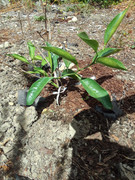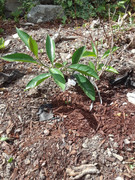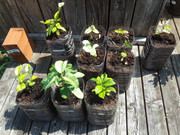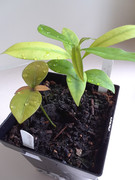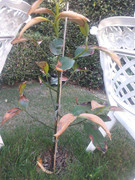1126
The Tropical Fruit Forum
Uniting Growers Worldwide!
News:
Email features have been reactivated 4/17/24
This section allows you to view all posts made by this member. Note that you can only see posts made in areas you currently have access to.
1127
Tropical Fruit Discussion / Re: Grow Japanese Cherry Tree in Florida?
« on: August 10, 2018, 11:24:23 PM »
I'm assuming you realize that Japanese cherries do not really produce edible fruit?
Also, just in case you were wondering, Japanese cherries could be regarded as a subspecies group within the same larger group as regular sweet cherries (the type you eat).
(Unlike all the other cherry groups I am aware of, these two groups actually have the same chromosome count, so it is possible for the two to interbreed to produce fertile offspring, although I would expect the vigor and health to be just a little bit stunted due to outbreeding depression. Okay, that's probably more information than you wanted to know. None of the hybrids they attempted produced very good cherry fruits)
Also, just in case you were wondering, Japanese cherries could be regarded as a subspecies group within the same larger group as regular sweet cherries (the type you eat).
(Unlike all the other cherry groups I am aware of, these two groups actually have the same chromosome count, so it is possible for the two to interbreed to produce fertile offspring, although I would expect the vigor and health to be just a little bit stunted due to outbreeding depression. Okay, that's probably more information than you wanted to know. None of the hybrids they attempted produced very good cherry fruits)
1128
Tropical Fruit Discussion / Re: Grow Japanese Cherry Tree in Florida?
« on: August 10, 2018, 02:45:31 AM »
Oh, also there's a few Japanese cherry varieties that have a lower chilling requirement and do much better in climates that don't have winter cold.
kanzakura, okame, and youkouzakura are three such relatively low-chill cultivars in Japan
Taiwan cherry (Prunus campanulata, also called Formosan cherry, and called kanhizakura in Japan) is one that is very popular in the U.S. in parts of the South.
It has a deep bright magenta color.
Pink Cloud is another one (it probably derived from P. campanulata pollinating a white flowered serrulata variety)
You might look up pictures of all of them, but in my personal opinion none of these lower chill varieties really have as attractive flowers as other varieties of Japanese cherry cultivars.
Despite the supposed chill hour requirement, it is possible for the standard Yoshino cultivar to grow and put out blossoms in climate zone 10.
I grew a very small one. I think they had more difficulty dealing with the heat and dryness than they did coming out of dormancy in the Spring.
All the very small Japanese cherries that were on their own roots survived. The one large one that was on grafted rootstock didn't survive, and I'm pretty it was in substantial part because it couldn't handle the lack of chill and just didn't have the vigor to really leaf out.
kanzakura, okame, and youkouzakura are three such relatively low-chill cultivars in Japan
Taiwan cherry (Prunus campanulata, also called Formosan cherry, and called kanhizakura in Japan) is one that is very popular in the U.S. in parts of the South.
It has a deep bright magenta color.
Pink Cloud is another one (it probably derived from P. campanulata pollinating a white flowered serrulata variety)
You might look up pictures of all of them, but in my personal opinion none of these lower chill varieties really have as attractive flowers as other varieties of Japanese cherry cultivars.
Despite the supposed chill hour requirement, it is possible for the standard Yoshino cultivar to grow and put out blossoms in climate zone 10.
I grew a very small one. I think they had more difficulty dealing with the heat and dryness than they did coming out of dormancy in the Spring.
All the very small Japanese cherries that were on their own roots survived. The one large one that was on grafted rootstock didn't survive, and I'm pretty it was in substantial part because it couldn't handle the lack of chill and just didn't have the vigor to really leaf out.
1129
Tropical Fruit Discussion / Re: Grow Japanese Cherry Tree in Florida?
« on: August 10, 2018, 02:28:22 AM »
Japanese cherry trees really have a problem dealing with heat, especially heat combined with high levels of humidity.
If you do try growing it I would suggest trying to grow it on its own roots (not grafted onto different rootstock, like the trees from the nursery normally are), it will be more vigorous that way, better being able to resist the lack of chill hours.
The leaves are likely going to get baked and scorched in the sun in the Summer, so you might want to start them off in containers in partial shade.
If you do try growing it I would suggest trying to grow it on its own roots (not grafted onto different rootstock, like the trees from the nursery normally are), it will be more vigorous that way, better being able to resist the lack of chill hours.
The leaves are likely going to get baked and scorched in the sun in the Summer, so you might want to start them off in containers in partial shade.
1130
Cold Hardy Citrus / Re: cold hardy Citrus for zone 7b?
« on: August 09, 2018, 08:31:26 PM »
This is a picture of a fairly large citrumelo tree growing in Winston-Salem, central North Carolina (zone 7b)
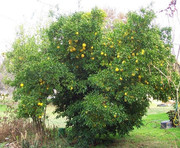
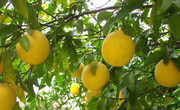
credit to Bob Snyder for the pictures of his tree
If you want to see some pictures of citrumelos surviving in a hard zone 8a climate, see this thread:
"Citrumelos in England"
http://tropicalfruitforum.com/index.php?topic=26155.0


credit to Bob Snyder for the pictures of his tree
If you want to see some pictures of citrumelos surviving in a hard zone 8a climate, see this thread:
"Citrumelos in England"
http://tropicalfruitforum.com/index.php?topic=26155.0
1131
Tropical Fruit Online Library / Re: The Incredible POMEGRANATE
« on: August 09, 2018, 08:11:41 PM »
I'm growing Parfianka and Crimson Sky in Olympia, WA. That's actually just a little bit farther north than Quebec City, Canada, or Duluth, Minnesota, if you care to pull out a map. These are both more cold-hardy varieties (and soft-seeded).
Regular pomegranate varieties can be grown here, but will die back to the ground about every 8 years when there's a colder winter.
As for whether there's enough heat to ripen the fruits, that depends on exactly which variety it is and what exact area you're in. Parts of the PNW get plenty of heat in the Summer, though the season may not last as long as it does in other places.
Regular pomegranate varieties can be grown here, but will die back to the ground about every 8 years when there's a colder winter.
As for whether there's enough heat to ripen the fruits, that depends on exactly which variety it is and what exact area you're in. Parts of the PNW get plenty of heat in the Summer, though the season may not last as long as it does in other places.
1132
Citrus General Discussion / Re: What happens if you try to breed Triploid citrus
« on: August 09, 2018, 03:42:51 PM »
I grew two seedlings from Shasta Gold mandarin (a triploid variety).
Both seedlings seem to be weak and very much lacking in vigor compared to other citrus variety seedlings. One of the seeds was almost certainly nucellar because it sent up multiple seedlings (and if you look very closely you can see a couple of different seedlings growing in that same container). The seedling in the other container (cup) came from a different Shasta Gold seed.
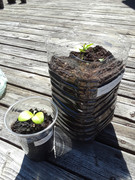
A very quick condensed summary of what we've learned so far: When growing seeds from a triploid citrus cultivar, some of them will be triploid and/or some of them will be normal diploid; all the triploid seeds will be nucellar (genetic clones of the fruit parent).
In very rare cases there might be a tetraploid seed, probably resulting when one of the triploid gametes (3n) escapes unreduced and combines with a normal haploid gamete (1n), resulting in a seed with a tetraploid (4n) zygotic embryo.
It's rather rare for a gamete to escape unreduced (meaning meiosis didn't divide the original chromosme set, when sexual gamete cells were being produced, that would be either the pollen or the ovaries of the fruit parent)
(Maybe only 1 out of 25 gametes are unreduced?)
The reason triploids are generally "seedless" (for the most part) is the problematic nature of what happens when a triploid chromosome (3n) set is split apart during meosis. It's not a normal division. (because it's an odd number, 3 cannot evenly be split into 2) So for the most part zygotic seeds fail to form or are very underformed. Yet a small number of normal zygotic seeds can form.
Both seedlings seem to be weak and very much lacking in vigor compared to other citrus variety seedlings. One of the seeds was almost certainly nucellar because it sent up multiple seedlings (and if you look very closely you can see a couple of different seedlings growing in that same container). The seedling in the other container (cup) came from a different Shasta Gold seed.

A very quick condensed summary of what we've learned so far: When growing seeds from a triploid citrus cultivar, some of them will be triploid and/or some of them will be normal diploid; all the triploid seeds will be nucellar (genetic clones of the fruit parent).
In very rare cases there might be a tetraploid seed, probably resulting when one of the triploid gametes (3n) escapes unreduced and combines with a normal haploid gamete (1n), resulting in a seed with a tetraploid (4n) zygotic embryo.
It's rather rare for a gamete to escape unreduced (meaning meiosis didn't divide the original chromosme set, when sexual gamete cells were being produced, that would be either the pollen or the ovaries of the fruit parent)
(Maybe only 1 out of 25 gametes are unreduced?)
The reason triploids are generally "seedless" (for the most part) is the problematic nature of what happens when a triploid chromosome (3n) set is split apart during meosis. It's not a normal division. (because it's an odd number, 3 cannot evenly be split into 2) So for the most part zygotic seeds fail to form or are very underformed. Yet a small number of normal zygotic seeds can form.
1133
Citrus General Discussion / Re: Valencia vs. Page Orange (mandarin) for fresh juice - which is better?
« on: August 09, 2018, 03:27:08 PM »
I would think Minneola tangelo would be better for juice than Page, since that is where Page gets most of its flavor from (one of its parents).
I think Minneola has better flavor than Orlando tangelo, but Orlando is said to be slightly cold-hardier.
Since I love Valencia juice, I can't make any comments about which one would be "better", they would just be different.
(standard commercial orange juice is usually made from Valencia, and for very good reason)
I've long thought about trying to attempt a hybrid between Valencia and Duncan grapefruit (one of the parent's of Minneola tangelo, and so ultimately an ancestor of Page mandarin). I bet that would have supreme juicing flavor.
I think Minneola has better flavor than Orlando tangelo, but Orlando is said to be slightly cold-hardier.
Since I love Valencia juice, I can't make any comments about which one would be "better", they would just be different.
(standard commercial orange juice is usually made from Valencia, and for very good reason)
I've long thought about trying to attempt a hybrid between Valencia and Duncan grapefruit (one of the parent's of Minneola tangelo, and so ultimately an ancestor of Page mandarin). I bet that would have supreme juicing flavor.
1134
Citrus General Discussion / Re: Thread for Citrus Breeders
« on: August 09, 2018, 03:24:04 PM »
related thread title:
"about how to breed seedless citrus varieties"
http://tropicalfruitforum.com/index.php?topic=24488.msg288562#msg288562
"about how to breed seedless citrus varieties"
http://tropicalfruitforum.com/index.php?topic=24488.msg288562#msg288562
1135
Citrus General Discussion / Re: Ponderosa lemon strange leaning leaves
« on: August 09, 2018, 01:49:54 PM »
It probably has something to do with heat or water stress, it could have something to do with a root issue, perhaps some root rot from overwatering in the past, or it could even be an early warning sign that there might be some disease in the roots (there's nothing really you can do about that).
I would just try to make sure your watering habits are good.
I would just try to make sure your watering habits are good.
1136
Citrus General Discussion / Re: Spider Mites
« on: August 09, 2018, 01:43:37 PM »
I use a mix of Pyrethrin and insect killing soap. I mix it from concentrate because the regular spray bottles would be too expensive considering the amount I go through. Periodically, about every 6 weeks, all the indoor ones are taken outside and thoroughly sprayed, then left outside for an hour or two (usually in the cold) to dry off.
1137
Citrus General Discussion / Re: Thread for Citrus Breeders
« on: August 09, 2018, 12:53:50 PM »
Here's the full reference for the Frost and Soost (1968) table:
H.B. Frost, R.K. Soost, (1968) Seed reproduction: development of gametes and embryos.
In: W. Reuther, L.D. Bachelor, H.J. Webber, The Citrus Industry, Volume II. Division of Agricultural Sciences. University of California Berkeley, pp 292-334
H.B. Frost, R.K. Soost, (1968) Seed reproduction: development of gametes and embryos.
In: W. Reuther, L.D. Bachelor, H.J. Webber, The Citrus Industry, Volume II. Division of Agricultural Sciences. University of California Berkeley, pp 292-334
1138
Citrus General Discussion / Re: Thread for Citrus Breeders
« on: August 09, 2018, 12:09:10 AM »
"Isozyme analysis was the basis for determining the frequency of occurrence and the characteristics of zygotic plants in Swingle citrumelo seedling populations from various sources of open-pollinated seeds, in a commercial nursery of Swingle citrumelo before and after roguing, and in commercial orchards and rootstock trials where this rootstock was used. Most zygotic seedlings identified by isozyme analysis could be distinguished by careful examination of morphological characteristics. Frequencies of zygotic seedlings varied among seedling populations, but were in the range (≈5% to 10%) found in previous studies. Roguing based primarily on size and growth habit of seedlings was effective in removing some, but not all, zygotic seedlings.
… prior studies showed that the frequency of zygotic plants in Swingle seedling populations maybe as high as 18% (Hutchison, 1974; Moore and Castle 1988, Xiang and Roose, 1988 )."
Isozymic Identification of Zygotic Seedlings in Swingle Citrumelo Citrus paradisi × Poncirus trifoliata Nursery and Field Populations, Catalina M. Anderson, William S. Castle, University of Florida, J. AMER. SOC. HORT. SCI. 116(2):322-326, 1991
http://journal.ashspublications.org/content/116/2/322.full.pdf
"The percentage of zygotic seedlings was <10 in C-32 citrange, Gomeri and Indio rough lemon, 10–30 in C.P.B. 4475 citrumelo, Cuban shaddock, Volkamer lemon and Yuma Ponderosa lemon, and >30 in Sacaton and Terra Bella citrumelos, Taiwanica sour orange and Yuma citrange. Small seed had lower germination and seedlings were smaller than those derived from normal seed. In all rootstocks except Yuma citrange, the frequency of zygotics in seedlings from small seed was not significantly different from that in populations derived from normal seed. Zygotic seedlings were generally shorter than nucellar seedlings. The distribution of height of zygotics considerably overlapped that of nucellars in most rootstocks, so that roguing by height alone was relatively ineffective. For the polyembryonic accessions studied, zygotic seedlings are as likely to occur in seeds producing 2 seedlings as in those producing 1 seedling."
Frequency and characteristics of nucellar and zygotic seedlings in 12 citrus rootstocks, C.Xiang, M.L.Roose, Scientia Horticulturae, Volume 37, Issues 1–2, November 1988, pages 47-59
… prior studies showed that the frequency of zygotic plants in Swingle seedling populations maybe as high as 18% (Hutchison, 1974; Moore and Castle 1988, Xiang and Roose, 1988 )."
Isozymic Identification of Zygotic Seedlings in Swingle Citrumelo Citrus paradisi × Poncirus trifoliata Nursery and Field Populations, Catalina M. Anderson, William S. Castle, University of Florida, J. AMER. SOC. HORT. SCI. 116(2):322-326, 1991
http://journal.ashspublications.org/content/116/2/322.full.pdf
"The percentage of zygotic seedlings was <10 in C-32 citrange, Gomeri and Indio rough lemon, 10–30 in C.P.B. 4475 citrumelo, Cuban shaddock, Volkamer lemon and Yuma Ponderosa lemon, and >30 in Sacaton and Terra Bella citrumelos, Taiwanica sour orange and Yuma citrange. Small seed had lower germination and seedlings were smaller than those derived from normal seed. In all rootstocks except Yuma citrange, the frequency of zygotics in seedlings from small seed was not significantly different from that in populations derived from normal seed. Zygotic seedlings were generally shorter than nucellar seedlings. The distribution of height of zygotics considerably overlapped that of nucellars in most rootstocks, so that roguing by height alone was relatively ineffective. For the polyembryonic accessions studied, zygotic seedlings are as likely to occur in seeds producing 2 seedlings as in those producing 1 seedling."
Frequency and characteristics of nucellar and zygotic seedlings in 12 citrus rootstocks, C.Xiang, M.L.Roose, Scientia Horticulturae, Volume 37, Issues 1–2, November 1988, pages 47-59
1139
Cold Hardy Citrus / Re: Long term cold hardy citrus breeding project
« on: August 06, 2018, 09:56:52 PM »1140
Cold Hardy Citrus / Re: Long term cold hardy citrus breeding project
« on: August 06, 2018, 01:06:49 AM »The main problem with kishu is that they are a such a very small fruit.Yes, but it's kind of a novelty. They make up for it by being seedless (if the blossoms were not pollinated) and effortless to peel. Little fruits would be frustrating if it took some effort to peel them, but with Kishu that is definitely not the case.
1141
Cold Hardy Citrus / Re: Long term cold hardy citrus breeding project
« on: August 04, 2018, 03:46:58 PM »
I do have some Page mandarin & Shasta Gold seedlings, so it would be interesting to eventually try to do something with that.
Two of the most delicious mandarin varieties, btw.
With the exception of Satsuma of course (but that's just individual personal preference talking).
Kishu produces 100% zygotic seeds and is also a very very good one. Believed to be one of the parents of Satsuma, although it doesn't have anywhere near the cold hardiness of Satsuma. Still, it would be a very easy one to cross. Satsuma produces about 90% nucellar seeds, on the other hand.
Two of the most delicious mandarin varieties, btw.
With the exception of Satsuma of course (but that's just individual personal preference talking).
Kishu produces 100% zygotic seeds and is also a very very good one. Believed to be one of the parents of Satsuma, although it doesn't have anywhere near the cold hardiness of Satsuma. Still, it would be a very easy one to cross. Satsuma produces about 90% nucellar seeds, on the other hand.
1142
Cold Hardy Citrus / Re: Long term cold hardy citrus breeding project
« on: August 04, 2018, 11:24:40 AM »
((C. ichangensis x Duncan grapefruit) x Satsuma mandarin) x Duncan Citrumelo)
(C. ichangensis x Satsuma) x (Satsuma x trifoliate)
(C. ichangensis x (Satsuma x trifoliate)) x ((Satsuma x trifoliate) x pomelo)
Duncan citrumelo x Bloomsweet
Just some ideas
(C. ichangensis x Satsuma) x (Satsuma x trifoliate)
(C. ichangensis x (Satsuma x trifoliate)) x ((Satsuma x trifoliate) x pomelo)
Duncan citrumelo x Bloomsweet
Just some ideas
1143
Cold Hardy Citrus / Re: Citrus in the Pacific Northwest
« on: August 01, 2018, 06:00:42 PM »
There was an interesting old thread on the Cloud Forest Gardener forum titled "hardy citrus, after the freeze", which discussed citrus growing outdoors in the PNW.
I'll copy some of the posts here in case the link disappears in the future.
____________________________
jim
Location: Vancouver Wa.
Climate Zone: sunset Z6, USDA 8b
Dec 02, 2010
Well, it's been over a week, enough time to evaluate the damage. While this freeze was not particularly severe compare to last year (48 consecutive hours below freezing with lows of 23F(-5C) and 17F(-8C) this year compare to 117 consecutive hours below freezing with four consecutive lows a degree around 11F(-11.6C) in December 09) the earliness of the freeze probably affected the plants a bit severely, since as Eric of the Dalles/gorge pointed out, plants have not had as much time to harden off compared to prior years.
I have a number of unprotected citrus that I'm evaluating for PNW hardiness, as well as some in christmas tree light heated mini-greenhouses. The greenhouse protected citrus were undamaged, fruit and all. In fact, it looks like the LA early Satsumas ripened a bit more, and may be ready by new years. The unprotected citrus:
Yuzu- the tips of the second growth flush were nipped back an inch or two, not surprising since the second growth flush never hardens off. This is comparable to previous years, except last year when all the second growth flush was killed.
Unprotected Changsha- slight tip dieback. This particular Changsha is the sole survivor of 23 unprotected seedlings I started out with two years ago, and survived (barely) last Decembers freeze, sort of unnatural selection of the hardiest variation of a random population.
Indio Mandarinquat- It's toast; white bark and dead leaves to the graft. Oh well, I was wondering where I was going to put the Kishu mandarin I'm protecting in a pot indoors.
Citrumelo- fully hardened off. No damage. It only had one growth flush this rather cool year.
Thomasville citrangequat seedlings- there are six in pots. The pots are set in the ground with soil to the top of the pot, to protect the roots. Three of them show some damage- slight bark whitening, tho the leaves look OK. The other three seem undamaged. There's also a one inch tall Sudachi seedling, which appears undamaged.
_________________________________
Las Palmas Norte
Location: Lantzville, Vancouver Island
Climate Zone: USDA zone 8b
Dec 02, 2010
My (potted) citrus had no issues with the last cold spell. They are in a large 1,000 square ft coldframe (polytunnel - British equivalant) and the smaller ones where just gathered together in the center area - no heat. I'm not sure of the temps in there but outside the coldest night on Nov.23 was -8.3°C (17°F).
Atwood Navel
Changsha mandarin
Owari satsuma
Yuzu
Ventura lemandrin
Sudachi
Meyer Lemon
10° Tangerine
... and several seed grown mandarins
My biggest problem was scale insect on some of these and now a black sooty mold has formed. Looks like a big maintenance issue come spring, should they make it.
Cheers, Barrie.
_____________________
jim
Location: Vancouver Wa.
Climate Zone: sunset Z6, USDA 8b
Dec 02, 2010
For an unprotected in-the-ground citrus, the Yuzu seems to work in the Portland area. My Yuzu has survived the last three winters unprotected. Part of it's hardiness, I suspect, is that it;s grafted to a true poncirus rootstock, giving it early dormancy. I haven't seen any problems with soot or scale. Perhaps because it's been outside, the rain washes off sticky sweet that causes sooty mold, and the freezes kill the scale. It's available from One Green World nursery, although I suspect, based on last years results, the 0F degree hardiness they claim may be overhyped. Also, it's actually used in cooking by the Japanese, although a lot of people don't care for the taste or texture. There are hardier citrus: the poncirus or trifoliate orange, the citrumelo, the citrange, etc. but most people can't stand the taste (although some are able to eat Citrumelo's, cutting out the sections like a grapefruit, which it resembles, making sure none of the bitter peel oil gets into the fruit. When or if mine sets fruit, I'll test the hypothesis). The following, somewhat more edible citrus may be as hardy, or hardier than the Yuzu, particularly if grafted onto a poncirus rootstock: Taiwanica lemon (seedy but edible, and, being a lemon, it will ripen here) Thomasville Citrangequat (some people don't like the taste, the one I got from Stan McKenzie tastes great, like a lime) Sudachi ( the one I have tastes fine to me, and it's used while still green, so ripening is not an issue. The ten degree tangerine, from Las Palma Nortes list, may also be hardy enough, and maybe the Juanita tangerine, but I haven't tried them (too many citrus, not enough room, or money) There are also things like yuzuquats and razzlequats and a host of other hybrids, enough to drive one mad
_______________________
eeldip
"George in Portland"
Climate Zone: 6/8b
Dec 02, 2010
i have a poncirus in the ground, and its been great. pretty close to my house, in the winter the contrast against the wall is incredible. stole that trick from the chinese gardens. it hasn't flowered yet though, making me sad...
_______________________
John S
Climate Zone: USDA8
Dec 06, 2010
Don't buy a 10 degree tangerine. I think it makes it in SC because it gets so much heat that it can lose some. Mine died here. I waited to put it out until it was bigger, and it still croaked. I'm being a little conservative on my citrus. I will put my yuzu out eventually but I wan't it to grow up. Flying dragon and Ichang lemon the only ones out all year and they're fine.
John S
PDX OR
____________________
jim
Location: Vancouver Wa.
Climate Zone: sunset Z6, USDA 8b
Dec 06, 2010
John, it's good to know about the 10 degree tangerine, something else to cross off the list. People who try out these different varieties help everyone else; out motto 'we kill exotic plants so others don't have to'. Even the Ichang can be iffy, mine was killed by last Decembers freeze, even though my grafted Yuzu survived. My guess is, the freeze came after a fairly warm November last year and sap was still flowing. When I inspected it, the bark was split and peeling, I'm guessing the flowing sap froze. The raging east winds probably did not help. If it had been grafted on Poncirus rootstock like the Yuzu, it may have gone dormant and survived.
________________________
John S
Climate Zone: USDA8
Nov 27, 2013
I love this thread. My yuzu died last winter, then regrew from roots and is a small bush again. Jim, I love your idea about growing it on flying dragon rootstock. Maybe I'll try to bud it this summer (2014). I have been almost killing my citrus for years. I love to see the experiments of others to see if I'm on the right track.
John S
PDX OR
_________________
jim
Location: Vancouver Wa.
Climate Zone: sunset Z6, USDA 8b
Nov 22, 2014
This is an update of this thread about the travails and joys of growing cold hardy citrus in the PNW, detailing the outcomes of nine unprotected citrus during the winter of 2013-2014.
Last winter was characterized by two significant Arctic blasts.
The first began Dec. 5th 2013 and ended Dec10th and was characterized by 113 consecutive hours below freezing, one low of 10.8F (-11.8C), one low of 13.6F (-10.2C), and four lows in the low 20's. Daytime highs were in the mid-high 20's on four of those days. This freeze also had strong east winds of 20 mph with gust to near 40 during the first couple days.
The second blast began Feb. 4th and ended Feb. 9th 2014 also with 113 consecutive hours below freezing. The nighttime lows were not particularly remarkable (for Portland), with three around 19F (-7.2C). What WAS noteworthy was a period of 36 consecutive hours where the temperature never rose above 21F (-6.1C). Daytime highs were also low-mid twenties for two other days.
The compost pile indicator shows that the ground froze solid to a depth of 12-15 inches during each of these two extended freezes.
Four of the nine unprotected citrus survived these two freezes:
Yuzu on Flying Dragon rootstock: 30% defoliated, one small twig died
Citrumelo on Flying Dragon rootstock: 20% defoliated, no small twig death.
Thomasville Citrangequat on Flying Dragon rootstock: 100% defoliation, 30-40% small twig death
First of twoThomasville Citrangequat seedlings on its own roots: killed to the ground, regrew one shoot in late July
The following five unprotected citrus died:
Troyer Citrange on it's own roots: This was the rootstock of the Kishu mandarin that died the previous winter.
Small 5 YO Changsha tangerine on it's own roots: This was the seedling that barely survived four nights near 10F in the of freeze of Dec. 2009. Not this time. Two freezes in one winter were two much for it , I guess.
Large 9 YO Changsha tangerine on it's own roots
Second of two Thomasville Citrangequat seedlings on it's own roots
Sudachi on Carrizo Citrange rootstock
A few additional observations
All of the five citrus that died looked pretty good until the weather warmed in late March, whereupon they turned brown and died. In fact, I was able use the wood in February to graft the two Changsha's and the Citrangequat seedling onto Flying Dragon rootstock, indicating the wood was still alive.
Second, none of the Citrus showed any signs of the bark splitting that indicates sap was flowing at the time of either of the freezes. Clearly they were all dormant.
Apparently, then, on the five plants that died ,it was the roots that were killed when the ground froze to a depth of 12-15 inches, i.e., the citrus themselves were top-hardy to 10F, but not root-hardy. The one Citrangequat one it's own roots that survived perhaps had a deep root that somehow survived, the root possibly protected by some Lingonberry plants that were growing fairly close to it.
This, then, seems to be a second mechanism whereby Deciduous Poncirus rootstock improves the hardiness of those cultivars grafted onto them. Not only does the rootstock cause the tops to go dormant, protecting it from bark-splitting death, but it also gives it a set of freeze-proof roots.
I was a little surprised that the Citrange died. It is reputed to be hardy to zero Fahrenheit. But then, Portland is a "hard" zone 8. Freezes here can last for up to two weeks without the temperature exceeding freezing, whereas in the South and Southeast, where most observation come from, temperatures of near 0F are often followed by rapid warmup above freezing in the following day or two.
Base on observed damage, the Citrumelo is somewhat hardier than the Yuzu. Both can probably take a few more degrees of frost, possibly to 5F, or even lower.
Both are hardier than the monofoliate clone of Citrangequat that I obtained from Mckenzie farms. The two Citrangequat seedlings appear hardier than that clone- both had some bifoliate and trifoliate leaves.
Only one of the Citrus -the Changsha- was grafted. The Sudachi was a rooted cutting.
http://www.cloudforest.com/cafe/gardening/hardy-citrus-after-the-freeze-t70.html
I'll copy some of the posts here in case the link disappears in the future.
____________________________
jim
Location: Vancouver Wa.
Climate Zone: sunset Z6, USDA 8b
Dec 02, 2010
Well, it's been over a week, enough time to evaluate the damage. While this freeze was not particularly severe compare to last year (48 consecutive hours below freezing with lows of 23F(-5C) and 17F(-8C) this year compare to 117 consecutive hours below freezing with four consecutive lows a degree around 11F(-11.6C) in December 09) the earliness of the freeze probably affected the plants a bit severely, since as Eric of the Dalles/gorge pointed out, plants have not had as much time to harden off compared to prior years.
I have a number of unprotected citrus that I'm evaluating for PNW hardiness, as well as some in christmas tree light heated mini-greenhouses. The greenhouse protected citrus were undamaged, fruit and all. In fact, it looks like the LA early Satsumas ripened a bit more, and may be ready by new years. The unprotected citrus:
Yuzu- the tips of the second growth flush were nipped back an inch or two, not surprising since the second growth flush never hardens off. This is comparable to previous years, except last year when all the second growth flush was killed.
Unprotected Changsha- slight tip dieback. This particular Changsha is the sole survivor of 23 unprotected seedlings I started out with two years ago, and survived (barely) last Decembers freeze, sort of unnatural selection of the hardiest variation of a random population.
Indio Mandarinquat- It's toast; white bark and dead leaves to the graft. Oh well, I was wondering where I was going to put the Kishu mandarin I'm protecting in a pot indoors.
Citrumelo- fully hardened off. No damage. It only had one growth flush this rather cool year.
Thomasville citrangequat seedlings- there are six in pots. The pots are set in the ground with soil to the top of the pot, to protect the roots. Three of them show some damage- slight bark whitening, tho the leaves look OK. The other three seem undamaged. There's also a one inch tall Sudachi seedling, which appears undamaged.
_________________________________
Las Palmas Norte
Location: Lantzville, Vancouver Island
Climate Zone: USDA zone 8b
Dec 02, 2010
My (potted) citrus had no issues with the last cold spell. They are in a large 1,000 square ft coldframe (polytunnel - British equivalant) and the smaller ones where just gathered together in the center area - no heat. I'm not sure of the temps in there but outside the coldest night on Nov.23 was -8.3°C (17°F).
Atwood Navel
Changsha mandarin
Owari satsuma
Yuzu
Ventura lemandrin
Sudachi
Meyer Lemon
10° Tangerine
... and several seed grown mandarins
My biggest problem was scale insect on some of these and now a black sooty mold has formed. Looks like a big maintenance issue come spring, should they make it.
Cheers, Barrie.
_____________________
jim
Location: Vancouver Wa.
Climate Zone: sunset Z6, USDA 8b
Dec 02, 2010
For an unprotected in-the-ground citrus, the Yuzu seems to work in the Portland area. My Yuzu has survived the last three winters unprotected. Part of it's hardiness, I suspect, is that it;s grafted to a true poncirus rootstock, giving it early dormancy. I haven't seen any problems with soot or scale. Perhaps because it's been outside, the rain washes off sticky sweet that causes sooty mold, and the freezes kill the scale. It's available from One Green World nursery, although I suspect, based on last years results, the 0F degree hardiness they claim may be overhyped. Also, it's actually used in cooking by the Japanese, although a lot of people don't care for the taste or texture. There are hardier citrus: the poncirus or trifoliate orange, the citrumelo, the citrange, etc. but most people can't stand the taste (although some are able to eat Citrumelo's, cutting out the sections like a grapefruit, which it resembles, making sure none of the bitter peel oil gets into the fruit. When or if mine sets fruit, I'll test the hypothesis). The following, somewhat more edible citrus may be as hardy, or hardier than the Yuzu, particularly if grafted onto a poncirus rootstock: Taiwanica lemon (seedy but edible, and, being a lemon, it will ripen here) Thomasville Citrangequat (some people don't like the taste, the one I got from Stan McKenzie tastes great, like a lime) Sudachi ( the one I have tastes fine to me, and it's used while still green, so ripening is not an issue. The ten degree tangerine, from Las Palma Nortes list, may also be hardy enough, and maybe the Juanita tangerine, but I haven't tried them (too many citrus, not enough room, or money) There are also things like yuzuquats and razzlequats and a host of other hybrids, enough to drive one mad
_______________________
eeldip
"George in Portland"
Climate Zone: 6/8b
Dec 02, 2010
i have a poncirus in the ground, and its been great. pretty close to my house, in the winter the contrast against the wall is incredible. stole that trick from the chinese gardens. it hasn't flowered yet though, making me sad...
_______________________
John S
Climate Zone: USDA8
Dec 06, 2010
Don't buy a 10 degree tangerine. I think it makes it in SC because it gets so much heat that it can lose some. Mine died here. I waited to put it out until it was bigger, and it still croaked. I'm being a little conservative on my citrus. I will put my yuzu out eventually but I wan't it to grow up. Flying dragon and Ichang lemon the only ones out all year and they're fine.
John S
PDX OR
____________________
jim
Location: Vancouver Wa.
Climate Zone: sunset Z6, USDA 8b
Dec 06, 2010
John, it's good to know about the 10 degree tangerine, something else to cross off the list. People who try out these different varieties help everyone else; out motto 'we kill exotic plants so others don't have to'. Even the Ichang can be iffy, mine was killed by last Decembers freeze, even though my grafted Yuzu survived. My guess is, the freeze came after a fairly warm November last year and sap was still flowing. When I inspected it, the bark was split and peeling, I'm guessing the flowing sap froze. The raging east winds probably did not help. If it had been grafted on Poncirus rootstock like the Yuzu, it may have gone dormant and survived.
________________________
John S
Climate Zone: USDA8
Nov 27, 2013
I love this thread. My yuzu died last winter, then regrew from roots and is a small bush again. Jim, I love your idea about growing it on flying dragon rootstock. Maybe I'll try to bud it this summer (2014). I have been almost killing my citrus for years. I love to see the experiments of others to see if I'm on the right track.
John S
PDX OR
_________________
jim
Location: Vancouver Wa.
Climate Zone: sunset Z6, USDA 8b
Nov 22, 2014
This is an update of this thread about the travails and joys of growing cold hardy citrus in the PNW, detailing the outcomes of nine unprotected citrus during the winter of 2013-2014.
Last winter was characterized by two significant Arctic blasts.
The first began Dec. 5th 2013 and ended Dec10th and was characterized by 113 consecutive hours below freezing, one low of 10.8F (-11.8C), one low of 13.6F (-10.2C), and four lows in the low 20's. Daytime highs were in the mid-high 20's on four of those days. This freeze also had strong east winds of 20 mph with gust to near 40 during the first couple days.
The second blast began Feb. 4th and ended Feb. 9th 2014 also with 113 consecutive hours below freezing. The nighttime lows were not particularly remarkable (for Portland), with three around 19F (-7.2C). What WAS noteworthy was a period of 36 consecutive hours where the temperature never rose above 21F (-6.1C). Daytime highs were also low-mid twenties for two other days.
The compost pile indicator shows that the ground froze solid to a depth of 12-15 inches during each of these two extended freezes.
Four of the nine unprotected citrus survived these two freezes:
Yuzu on Flying Dragon rootstock: 30% defoliated, one small twig died
Citrumelo on Flying Dragon rootstock: 20% defoliated, no small twig death.
Thomasville Citrangequat on Flying Dragon rootstock: 100% defoliation, 30-40% small twig death
First of twoThomasville Citrangequat seedlings on its own roots: killed to the ground, regrew one shoot in late July
The following five unprotected citrus died:
Troyer Citrange on it's own roots: This was the rootstock of the Kishu mandarin that died the previous winter.
Small 5 YO Changsha tangerine on it's own roots: This was the seedling that barely survived four nights near 10F in the of freeze of Dec. 2009. Not this time. Two freezes in one winter were two much for it , I guess.
Large 9 YO Changsha tangerine on it's own roots
Second of two Thomasville Citrangequat seedlings on it's own roots
Sudachi on Carrizo Citrange rootstock
A few additional observations
All of the five citrus that died looked pretty good until the weather warmed in late March, whereupon they turned brown and died. In fact, I was able use the wood in February to graft the two Changsha's and the Citrangequat seedling onto Flying Dragon rootstock, indicating the wood was still alive.
Second, none of the Citrus showed any signs of the bark splitting that indicates sap was flowing at the time of either of the freezes. Clearly they were all dormant.
Apparently, then, on the five plants that died ,it was the roots that were killed when the ground froze to a depth of 12-15 inches, i.e., the citrus themselves were top-hardy to 10F, but not root-hardy. The one Citrangequat one it's own roots that survived perhaps had a deep root that somehow survived, the root possibly protected by some Lingonberry plants that were growing fairly close to it.
This, then, seems to be a second mechanism whereby Deciduous Poncirus rootstock improves the hardiness of those cultivars grafted onto them. Not only does the rootstock cause the tops to go dormant, protecting it from bark-splitting death, but it also gives it a set of freeze-proof roots.
I was a little surprised that the Citrange died. It is reputed to be hardy to zero Fahrenheit. But then, Portland is a "hard" zone 8. Freezes here can last for up to two weeks without the temperature exceeding freezing, whereas in the South and Southeast, where most observation come from, temperatures of near 0F are often followed by rapid warmup above freezing in the following day or two.
Base on observed damage, the Citrumelo is somewhat hardier than the Yuzu. Both can probably take a few more degrees of frost, possibly to 5F, or even lower.
Both are hardier than the monofoliate clone of Citrangequat that I obtained from Mckenzie farms. The two Citrangequat seedlings appear hardier than that clone- both had some bifoliate and trifoliate leaves.
Only one of the Citrus -the Changsha- was grafted. The Sudachi was a rooted cutting.
http://www.cloudforest.com/cafe/gardening/hardy-citrus-after-the-freeze-t70.html
1144
Citrus General Discussion / Re: Thread for Citrus Breeders
« on: August 01, 2018, 03:20:35 PM »
How often do tetraploids spontaneously arise from seedlings?
" In the framework of the IVIA triploid breeding program (Navarro et. al.), we have searched for tetraploids plants in seedling populations of 'Anana', 'Fairchild', 'Kara', 'Page', 'Saltemta', 'Simeto', 'Sunburst' and 'Tardivo di Ciaculli' mandarins, 'Afourer', 'Murcott' and 'Ortanique' tangors, 'Mapo'and 'Minneola' tangelos, 'Duncan' and 'Star Ruby' grapefruits and 'Sanguinelli' orange. Determination of ploidy level was made by flow cytometry and genetic analysis to confirm their genetic origin with 31 SSRs markers. Tetraploid plants were found in ail genotypes analyzed, except 'Salteiiita' and 'Simeto' mandarins, but the frequency of tetraploids varied with the genotype. 'Kinnow' mandarin produced the larger number of tetraploids plants (9.7%), whereas 'Page' mandarin produced the smaller percentage (0.5%). "
(Selection of spontaneous autotetraploid plants from Citrus polyembryonic cultivars, Pablo Aleza Gil, Patrick Ollitrault, Luis Navarro, Polytechnic University of Valencia, 2008 )
" In the framework of the IVIA triploid breeding program (Navarro et. al.), we have searched for tetraploids plants in seedling populations of 'Anana', 'Fairchild', 'Kara', 'Page', 'Saltemta', 'Simeto', 'Sunburst' and 'Tardivo di Ciaculli' mandarins, 'Afourer', 'Murcott' and 'Ortanique' tangors, 'Mapo'and 'Minneola' tangelos, 'Duncan' and 'Star Ruby' grapefruits and 'Sanguinelli' orange. Determination of ploidy level was made by flow cytometry and genetic analysis to confirm their genetic origin with 31 SSRs markers. Tetraploid plants were found in ail genotypes analyzed, except 'Salteiiita' and 'Simeto' mandarins, but the frequency of tetraploids varied with the genotype. 'Kinnow' mandarin produced the larger number of tetraploids plants (9.7%), whereas 'Page' mandarin produced the smaller percentage (0.5%). "
(Selection of spontaneous autotetraploid plants from Citrus polyembryonic cultivars, Pablo Aleza Gil, Patrick Ollitrault, Luis Navarro, Polytechnic University of Valencia, 2008 )
1145
Tropical Fruit Discussion / Re: G. hombriana and G. mangostana, over two months
« on: July 31, 2018, 02:03:30 PM »1146
Temperate Fruit Discussion / Re: Pyrus intercompatibility: Nashi (pyrifolia) badly dwarfed on Europear (communis)
« on: July 27, 2018, 08:47:52 PM »
Perhaps you should have tried Comice pear. It is one of the few pears considered to show good intercompatibility with quince rootstock, and is also the most delicious variety.
1147
Cold Hardy Citrus / Re: How many of you here have cold-hardy citrus that was grown from seedlings?
« on: July 26, 2018, 06:01:10 PM »I have a Dunstan citrumelo that's been in ground from seed 5 years old, some 80-5 citrumelo seedlings planted last fall, some Ichangensis seedlings planted from seed last fall.Ichangensis is especially promising because it is a zygotic variety.
Seeds from citrumelo, I am guessing, will be about 70-90% nucellar (like grapefruit) but I've never seen any exact sources.
There have been at least two reports of citrange grown from seed that turned out not to have any noticable trifoliate bitterness.
1148
Cold Hardy Citrus / Re: How many of you here have cold-hardy citrus that was grown from seedlings?
« on: July 23, 2018, 06:54:34 PM »
Maybe it's important, if any of you have possibly hybrid seeds, to distribute them to others, especially those who may live in a bit warmer climates.
Of course the growing and propagating part of breeding cold hardy citrus would be easier in warmer climates, yet there's little interest in trying to breed cold hardy citrus among people who live in climates where normal citrus can easily be grown.
I suppose the ideal breeding program would involve a partnership of some people living in colder climates and someone else living in a warmer climate willing to propagate the seeds, and then eventually send cuttings or plants back, where they can be grown and tested in the colder climates.
Also, if any of you have rarer cold hardy citrus varieties, when the plant fruits it would be good to distribute the seeds to other cold hardy citrus growers who are on a list.
Of course the growing and propagating part of breeding cold hardy citrus would be easier in warmer climates, yet there's little interest in trying to breed cold hardy citrus among people who live in climates where normal citrus can easily be grown.
I suppose the ideal breeding program would involve a partnership of some people living in colder climates and someone else living in a warmer climate willing to propagate the seeds, and then eventually send cuttings or plants back, where they can be grown and tested in the colder climates.
Also, if any of you have rarer cold hardy citrus varieties, when the plant fruits it would be good to distribute the seeds to other cold hardy citrus growers who are on a list.
1149
Cold Hardy Citrus / How many of you here have cold-hardy citrus that was grown from seedlings?
« on: July 23, 2018, 09:26:24 AM »
How many of you here have cold-hardy citrus that you grew from seed?
I ask because this could lead to new hybrids. Seedlings don't always have the same genetic mix as their parents. Sometimes a seedling will have better tasting fruit or be more cold hardy.
It's also a simple cheap way (although time & effort intensive) to propagate more plants.
I ask because this could lead to new hybrids. Seedlings don't always have the same genetic mix as their parents. Sometimes a seedling will have better tasting fruit or be more cold hardy.
It's also a simple cheap way (although time & effort intensive) to propagate more plants.
1150
Tropical Fruit Discussion / Re: giving mangosteen a try in Southern California
« on: July 20, 2018, 09:53:48 PM »SMF spam blocked by CleanTalk

